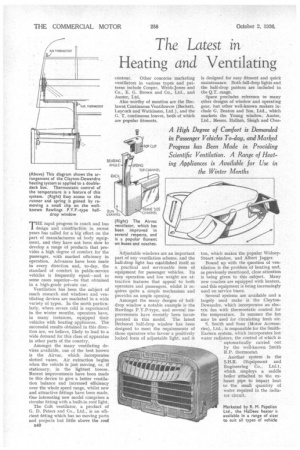The Latest in
Page 50

Page 51

If you've noticed an error in this article please click here to report it so we can fix it.
Heating and Ventilating A High Degree of Comfort is Demanded in Passenger Vehicles To.-day, and Marked Progress has Been Made in Providing Scientific Ventilation. A Range of Heat-, ing Appliances is Available for Use in
the Winter Months
THE rapid progress in coach and bus design and construction in recent years has called for a big effort on the part of manufacturers of body equipment, and they have not been slow to develop a range of products that provides a high degree of comfort for the passenger, with marked efficiency in operation. Advances have been made in every direction and, to-day, the standard of comfort in public-service vehicles is frequently equal—and in some cases superior—to that obtained in a high-grade private car.
Ventilation has been the subject of much research and windows and ventilating devices are marketed in a wide variety of types. In the north particularly, where .severe cold is experienced in the winter months, operators have, in many instances, equipped their vehicles with heating appliances. The successful results obtained in this direction are, we believe, likely to lead to a wide demand for this class of apparatus in other parts of the country.
Amongst the many ventilating devices available, one of the best known is the Airvac, which incorporates slotted vanes. Air extraction begins when the vehicle is just moving, or, if stationary, in the lightest breeze. Recent improvements have been made to this device to give a better ventilation balance and increased efficiency over the whole speed range, whilst new and attractive fittings have been made. One interesting new model comprises a circular fitting with a built-in roof light.
The Colt ventilator, a product of G. D. Peters and Co., Ltd., is an efficient fitting which has no moving parts and projects but little above the roof contour. Other concerns marketing
ventilators in various types and patterns include Cooper, Webb-Jones and Co., E. G. Brown and Co., Ltd., and Auster, Ltd, Also woithy of mention are the Beclawat Continuous Ventilouvre (Beckett, Layeock and Watkinson, Ltd. J, and the G. T. continuous louvre, both of which are popular fitments.
Adjustable windows are an important part of any ventilation scheme, and the half-drop light has established itself as a practical and serviceable item of equipment for passenger vehicles. Its easy operation and low weight are attractive features that appeal to both operators and passengers, whilst it requires quite a simple mechanism and provides an ample opening.
Amongst the many designs of halfdrop window a notable example is the Rawlings P.Y.P-type, and several improvements have recently been incorporated in this model. The latest Beclawat half-drop window has been designed to meet the requirements of those operators who favour a positively locked form of adjustable light, and it
is designed for easy fitment and quick maintenance. Both full-drop lights and the half-drop pattern are included in the Q.T. range.
Space precludes reference to many qther designs of window and operating gear, but other well-known makers include G. Beaton and Son, Ltd., which markets the Young window, Auster, Ltd., Messrs. Hallam, Sleigh and Ches ton, which makes the popular WidneyStuart window, and Albert Jagger.
Bound up with the question of ventilation is the problem of heating and, as previously mentioned, close attention is being given to this subject. Many new coaches are equipped with heaters, and this equipment is being increasingly used on service buses.
Several systems are available and a largely used make is the ClaytonDewandre, which incorporates an electric fan with thermostatic control for the temperature. In summer the fan may be used for circulating fresh air.
S. Smith and Sons (Motor Accessories), Ltd., is responsible for the SmithEastern system, which incorporates hot water radiators, the control of which is automatically carried out by the well-known Smith R.P. thermostat.
Another system is the S.H.R. (Equipment and Engineering Co., Ltd.), which employs a saddle boiler attached to the exhaust pipe to impart heat to the small quantity of water required in the radiator circuit. R. M. Papelian, Ltd., handles the HaDees heater which is available in several sizes to suit all types of vehicle. The price of this equipment is reasonable and it is obtainable either. for 6-volt or 12-volt operation. A simple heater-ventilator is the Benwat, which is a product of the Nu-Auto and General Utilities concern.
Although designed primarily for use in the summer and having as its object the provision of the maximum fresh air and sunlight for coach passengers, the opening roof has a direct bearing on the question of ventilation. This survey of ventilating and heating equipment would not, therefore, be complete without some reference to this popular fitment.
Amongst the makers of sliding or folding roofs may be mentioned Weathershields, Ltd., which markets a. neat sliding roof for buses and coaches. An opening roof for drivers' cabs is another speciality of this concern.
Sunsaloon Bodies, Ltd., has developed a range of opening roofs and Wilfred Overton is responsible for the well-known Wolrnan head. Other makers include Quicktho (1928), Ltd., which markets the Q.T. Easiway sliding roof, and the Eastern Counties Omnibus Co., Ltd. (coachbuilding department). In the construction of these opening heads there is much ingenious mechanism which well repays careful examination.
Useful fitments for coaches in the summer are small electric fans and
Feeny and Johnson, Ltd., manufactures a wide range of these appliances.
The list below gives the names and addresses of concerns marketing heating and ventilating, appliances and •equipment, and it will constitute a useful reference,




















































































